Creativity in the Digital Age
by : Adi Sethna FRPS AFIAP
With the advent of digital imaging the scope for creativity in photography is without limit and a discussion on this subject is now more than appropriate. Creativity needs to be seen in its historical context. Ever since the inception of photography there has been the false assumption that photography depicts reality. This is far from the truth. For several decades only black and white photography existed, although everything photographed was in colour as the world is in colour. The black and white images hardly depicted reality and the photographer had to interpret the world in colour in black, white and shades of grey.
In the modern world the colour passport photograph is probably the best example of photography purporting to depict reality, but does it? Most would admit it to be the least flattering way of presenting a portrait as most facilities for taking passport photographs have the camera far too close to the face, which produces a distorted perspective with a large nose and small ears. Immigration officers hardly ever see faces at such close quarters and must need considerable skill to spot the likeness. In this day and age it is not a good example of depicting reality.
I would suggest that depicting reality in photography never existed and is a myth. If photography was meant only to depict reality it would have been so boring that club photography, the RPS, Salons and Exhibitions of Photography would not have existed. From the outset photographers have been altering and enhancing images to make them more aesthetically and artistically appealing, turning photography into an art form. To understand photography as an art form we need to look at other arts like music and literature. In my view all art forms affect us emotionally and, to a very limited extent, intellectually. This emotional reaction affects our mood and feelings, makes us happy or sad and creates in us, in modern terminology, a “high”. I often say when I have listened to good music that I have had my “fix”. Photography is no exception to this; images convey mood and feelings and, at times, complex emotions which are difficult or impossible to verbalise and which are not always pleasurable. In some instances we admire the cleverness of the photographer for incorporating, for example, symbolism in an image. Though the last two points might appear to be intellectual, it is the emotional counterpart that moves us.
We are now in a position to describe creativity. It is the act of altering an image as seen to make it aesthetically appealing or artistic. Creativity is expressed at several stages in the production of an image and starts at the taking stage by :
a) the choice of subject matter; a whole article could be written on this topic, but by way of example the image in Figure 1 was taken by my friend Hugh Milsom MFIAP in the early 80’s and has been highly successful in Exhibitions and Salons. But who would have thought of making an exhibition image of a rotting post? A straight print from the negative is also shown and illustrates the degree of creativity in the final image.
b) the selection of the camera settings (aperture, shutter speed, focal length, etc.).
c) the selection of view point.
d) the exploitation of perspective (the relative positioning of camera and subject matter).
e) framing (what is included or not included in the image).
f) the choice of medium - colour or black and white.
Fig 1 Fence Post © Hugh Milsom MFIAP Original image (left), Final image (right).
The scope for creativity is even greater at the processing stage, either in the darkroom or digitally. Although the degree of creativity possible in the dark room is considerable and in digital imaging practically limitless, creativity at the taking stage remains of fundamental importance.
If what is said above is true the so called ‘straight’ image has never existed and all images are creative to a greater or lesser extent. In a ‘straight’ image the amount of creativity might be less, but it’s quality could outclass a so called ‘creative’ image.
Quite often images which most people would accept as ‘straight’ are anything but straight. Examples of such images are shown in the work of Hugh Milsom in Fig 2, of Peter Clark in Figs 3 & 4 and my own image in Fig 5. In the image ‘Road to the Cuillins’ by Hugh Milsom shown in Fig 3 the patch of light on the road never existed and was created in the darkroom along with the dramatic sky. This was done in the early 80’s; if done now digitally many would say it was cheating.
Fig 2 Road to the Cuillins © Hugh Milsom MFIAP Original image (left), Final image (right).
Fig 3 Lindisfarne © Peter Clark FRPS EFIAP/p PPSA Original image (left), Final image (right).
Fig 4 Desolate © Peter Clark FRPS EFIAP/p PPSA Original image (left), Final image (right).
Fig 5 Cumbrian Landscape © Adi Sethna FRPS AFIAP Original image (left), Final image (right).
All of the four final images would look perfectly straight to any viewer, but when compared with the corresponding images produced directly from the negative or digital file it can be seen that they are anything but ‘straight’ and are highly creative.
In my opinion so called ‘straight’ images and ‘creative’ images are equally valid and of equal worth and importance. The only difference between them is the nature and level of creativity. These two categories of images, therefore, should not be put in different classes In competitions and exhibitions.
Creativity which follows the taking stage in the darkroom or digitally has two aspects and although there is a significant difference between them there is also considerable overlap. These two aspects of creativity are best explained through illustrations, but must first be defined. They are :
a) Alteration of the elements of the image. This means altering the structure or appearance of the component parts of the image. Examples of how this may be achieved include the use of filters, the use of fundamental techniques to alter contrast, enhance or suppress details, modify colour and colour saturation, in addition to the use of specialist techniques such as posterisation, etc., and by the choice of paper – gloss or matt, smooth or textured on which to print the image.
b) Alteration of the subject matter or the content of the image. This implies a composite image made up of two or more images, the combination of which creates something which in reality did not exist, but could have, or to produce an image which could never have existed in reality. Composite images may be of two types, those in which the primary image is complimented by the inclusion of a secondary image and those which are wholly made up of several images.
It cannot be said after reading this article that I believe that creative images are in any way superior to straight images. However, I find that in National and International exhibitions in this country far too few ‘creative’ images are selected and are very rarely given top awards. This is not the case abroad in my experience. This article is not the right place to go into further details of why this is the case, but I very much hope that this article helps in redressing the situation.
Record Photography
While we are on the subject of exhibitions, competitions and judging, if a work is not to be submitted for selection or competition or included in a lecture the terms ’straight’, ‘creative’, pictorial, record etc are redundant.
As I have laboured on the subject of ‘straight’ and ‘creative’ photography I would also like to express my views on the term ‘record’ photography and again in the context in competitions and exhibitions. I find that judges call images ‘record’ photographs depending upon the subject matter; for instance architecture and natural history are supposed to be record photography, but in both these categories pictures could be highly artistic and indeed would need to be if they are to succeed. Subject matter alone does not determine whether or not an image is a record photograph.
In my opinion a record photograph is one where the purpose of taking the image is either stated or implied and is solely for the purpose of recording and may or may not have artistic quality. Examples would be a passport photograph and illustrations made for a technical book. A picture of a bird taken to illustrate different types of feathers for a book on birds would be a record image, but if submitted for selection in a natural history competition or exhibition it may or may not be viewed as a record photograph, and if it is truly a record picture as described here it will not succeed.
Snaps taken on a holiday for the sole purpose of recording the sights visited are pure record photographs and may or may not have artistic quality. Few of my holiday pictures and those of other photographers are taken for the purpose of recording the sights that we saw, but with the intention of creating an artistic image. It would be wrong therefore to say that holiday pictures are record photography; it is not the subject matter which makes the photograph a record shot, but the purpose for which the picture was taken and invariably this is not with the intention of creating a piece of art.
The following images and their captions illustrate the points made in this article.
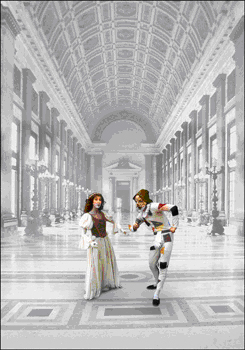
Court Jesters
This image illustrates the two aspects of creativity; the background is an example of altering the elements of an image and the addition of the figures compliments the background to create an entirely new image.
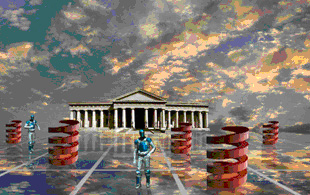
New World
This image illustrates how ideas developed over time can be represented in an image which could have never existed in reality. I often try to imagine what the world would be like in the next century. I believe there will be new materials and what could be better than a material with the combined properties of glass and steel and the floor in the image is represented by that material. Although great advances will be made in physical sciences, I believe that these will be outstripped by those in genetics by a long way and that is shown in the image by the coils representing the double helix of the DNA molecule. What will remain of the past in the next century? Possibly some of the structures of today will survive as have the Pyramids and the Taj Mahal from earlier times and these are represented by the building in the background.
I would also expect that all communicable diseases would have been eradicated as smallpox has been in our times. If that happens people would have no immunity in such a sterile world and infective agents, possibly lurking in the old monuments, would require people visiting them to wear protective clothing as worn by the two men in the image. This image is a prime example of the use of symbolism in creativity.
|
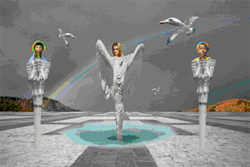
Salvador Angeli
|
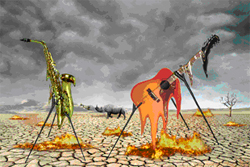
Salvador Barbaqui
|
|
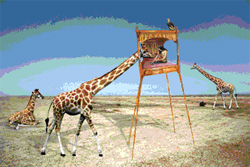
Salvador Giraffi
|
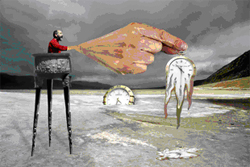
Salvador Timei
|
I often spend a lot of time and effort to work out a creative image in my mind and have always wondered about the thought processes of some of the great modern artists such as Picasso or Dali. As an exercise, I made myself think like Dali and used the basic elements seen in his paintings to produce this panel of four images without plagiarising any of his existing paintings.
I can describe what each of these images mean to me, as I have done so when commenting on ‘New World’, but I have refrained for two reasons. Firstly because this article would get inordinately long and secondly any art form should allow the viewer to project his own thoughts, ideas and imagination on a piece of art. I would be very interested to hear from readers what they see in these images. In my lecture on this subject I express my interpretation on one of the images as an example.
|

Pilgrims
|
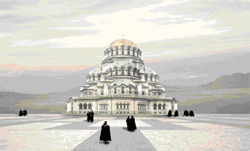
Worshippers
|
I have been a long standing student of life after death and I often imagine what different places would be like up there. I thought of an empty plateau occupied by similar minded people; ‘Pilgrims’ is my impression of a place inhabited by Muslim spirits and “Worshippers” by Christian spirits.
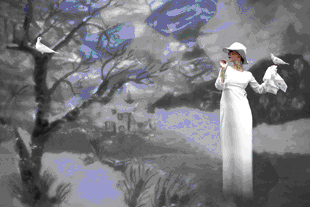
Fantasy
I believe that objects or a piece of art need no explanation by the author and it is for the viewer to project their own thoughts, feeling and imagination on the artistic creation. I therefore asked my wife what she saw in this image when I first produced it. She liked it and praised the image unlike her usual sharp, critical comments, She felt that the young woman in the picture had once lived in the house shown in the background, but had died prematurely and had returned in spirit form to play with her beloved doves. Though this picture has been very successful in various International exhibitions, when put in a club competition the only comment of the judge was that the dove in the tree was too sharp and needed to be soft like the rest of the background!
|
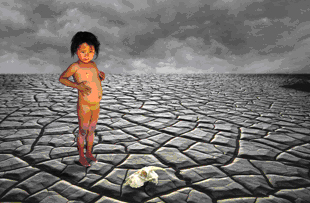
Wilderness Child
|

Legacy
|
Both images are composites. The individual components have no message or artistic merit, but when put together they have strong impact. The meaning of the title ‘Legacy’ might not be apparent. What I had in mind was that Ché Guevara is questioning the destitute as to whether he was the legacy of the several decades of communism which he co-founded with Fidel Castro. My visit to Cuba produced a lot of conflicting emotions and the images from that country are representative of that fact.
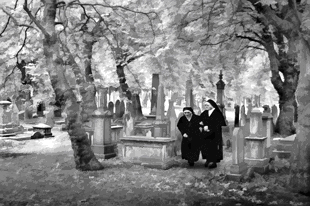
Cemetery
The background image was taken in an old cemetery and was given a painterly treatment and the nuns were put in to add interest and to provide a focal point. The original colour image was converted to black and white as it transformed the image to my liking.
This article is based on a talk given to the Digital Imaging Group of Smethwick Photographic Society in which many more creative images were shown.
Acknowledgements.
Without the help of my friend Peter Clark in giving me ideas, discussing the concept of creativity and in preparing the text and images I could not have written this article,
I also wish to thank Hugh Milsom for allowing me to include his images.